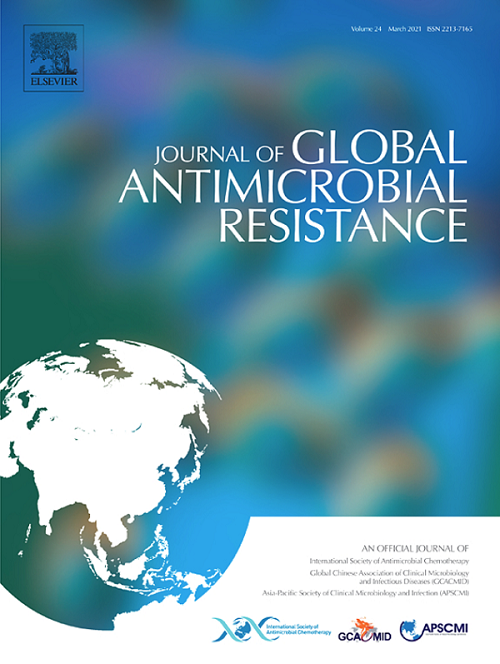从阿根廷肠杆菌中回收的 blaNDM-5-harbouring 质粒的整体基因组描述。
IF 3.7
3区 医学
Q2 INFECTIOUS DISEASES
引用次数: 0
摘要
目的鉴定在阿根廷分离的肠杆菌中发现的四种与 blaNDM-5 相关的质粒:DNA由Illumina和牛津纳米孔技术测序,用Unicycler组装,用PlasmidFinder、MOB-Typer、IslandViewer4和Resfinder分析,用Proksee和Clinker可视化。结果:两个质粒属于不相容组IncFII,其中blaNDM-5位于先前描述的遗传背景中,浸没在抗菌药耐药性岛(ARI)中。本地 IncFII 质粒与 PLSDB 中的 4 个质粒具有高度相似性(共享哈希值(sh)≥ 90%)。另外两个本地质粒属于多复制子组 IncFIB-HI1B,以一种新的基因变异形式携带 blaNDM-5。这两个多复制子质粒都有两个ARI,其中一个含有blaNDM-5和其他ARM;第二个ARI含有blaCTX-M-15和一个1类整合子。存入 PLSDB 的质粒与本地多重复制质粒的相似度较低。最相似的质粒(n:5)的相似度低于 60%,显示出相同的 Inc 群,但缺乏 ARM:这项研究拓宽了人们对拉丁美洲 blaNDM-5 相关质粒的有限了解。此外,该研究首次描述了blaNDM-5在共同遗传平台中的新型变体及其在多重复制的IncFIB-IncHI1B质粒中的位置,而这些质粒以前未与任何抗菌药耐药性标记(ARM)相关联。本文章由计算机程序翻译,如有差异,请以英文原文为准。
Integral genomic description of blaNDM-5-harbouring plasmids recovered from Enterobacterales in Argentina.
Objective
To characterise four blaNDM-5-harbouring plasmids recovered in Enterobacterales isolated in Argentina.
Methods
DNA was sequenced by Illumina and Oxford Nanopore Technologies, assembled using Unicycler, analysed using PlasmidFinder, MOB-Typer, IslandViewer4, and Resfinder, and visualised by Proksee and Clinker. blaNDM-5-harbouring plasmids were compared with similar deposited plasmids using PLSDB.
Results
Two plasmids belonged to incompatibility group IncFII where blaNDM-5 was located in a previously described genetic context, immersed in an antimicrobial resistance island (ARI). Local IncFII plasmids displayed high similarity (≥90% shared hashes (sh)), with four deposited in PLSDB. The other two local plasmids belonged to the multi-replicon group IncFIB-HI1B, harbouring blaNDM-5 in a novel variant of the genetic context. Both multi-replicon plasmids presented two ARIs, one containing blaNDM-5 in addition to another antimicrobial resistance marker (ARM), and the second ARI carrying blaCTX−M-15 and a class 1 integron. Plasmids deposited in PLSDB showed low similarity to local multi-replicon plasmids. The most similar plasmids (n = 5) displayed less than 60% shared hashes and showed the same Inc groups but lacked ARM.
Conclusions
This study broadens the limited understanding of blaNDM-5-harbouring plasmids in Latin America. Furthermore, it represents the first description of blaNDM-5 in a novel variant of common genetic platform and its location in multi-replicon IncFIB-IncHI1B plasmids, which were not previously associated with any ARM.
求助全文
通过发布文献求助,成功后即可免费获取论文全文。
去求助
来源期刊

Journal of global antimicrobial resistance
INFECTIOUS DISEASES-PHARMACOLOGY & PHARMACY
CiteScore
8.70
自引率
2.20%
发文量
285
审稿时长
34 weeks
期刊介绍:
The Journal of Global Antimicrobial Resistance (JGAR) is a quarterly online journal run by an international Editorial Board that focuses on the global spread of antibiotic-resistant microbes.
JGAR is a dedicated journal for all professionals working in research, health care, the environment and animal infection control, aiming to track the resistance threat worldwide and provides a single voice devoted to antimicrobial resistance (AMR).
Featuring peer-reviewed and up to date research articles, reviews, short notes and hot topics JGAR covers the key topics related to antibacterial, antiviral, antifungal and antiparasitic resistance.
 求助内容:
求助内容: 应助结果提醒方式:
应助结果提醒方式:


